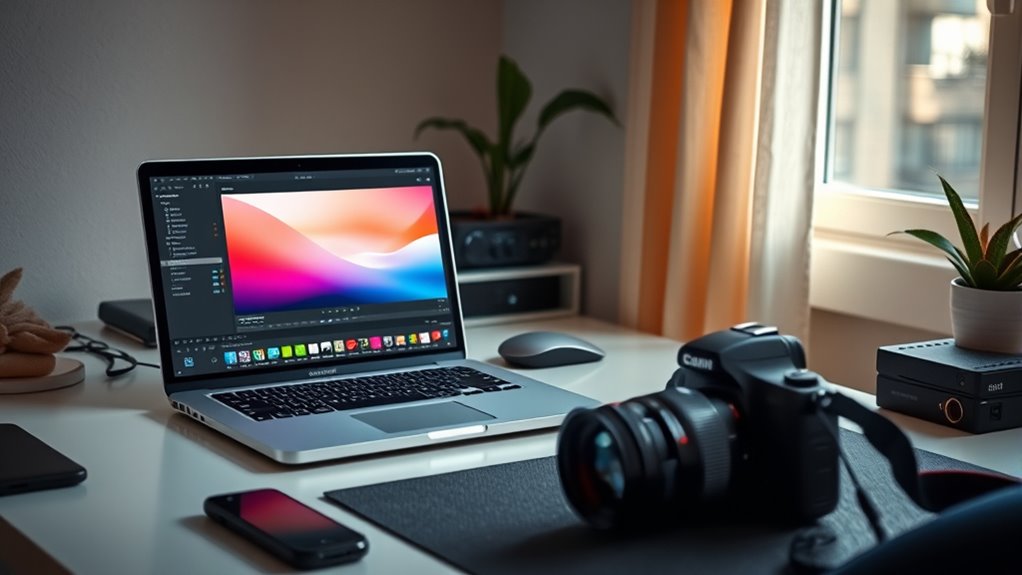To fix color tints quickly, start by using your phone or computer’s built-in editing tools. Adjust the tint slider to balance out green or magenta casts—move it slightly until colors look natural. Fine-tune brightness and contrast afterward for clarity. Using automatic corrections can give a good starting point, then make small manual tweaks. With practice, you’ll learn simple steps to achieve professional results within just 15 minutes—keep going to discover even more tips.
Key Takeaways
- Use the tint slider in your editing software to quickly neutralize unwanted color casts with small, incremental adjustments.
- Enable automatic color correction as a starting point, then fine-tune manually for natural results within 15 minutes.
- Adjust temperature and contrast after tint correction to enhance overall image clarity efficiently.
- Apply targeted filters or overlays to fix localized tint issues without affecting the entire image.
- Practice quick corrections regularly to develop an intuitive eye for efficient, professional-looking color fixes.
Simple Techniques to Correct Color Tints Quickly

If your photos or videos have a color tint that doesn’t look right, fixing it can dramatically improve their appearance. When you’re aiming for quick results, understanding basic color adjustment techniques and tint application methods can make all the difference. You don’t need complex software or hours of editing; a few simple steps can restore the natural look of your visuals in just 15 minutes.
Start by opening your editing tool of choice—most smartphones and computers come with built-in options that are user-friendly. Once you load your media, look for the color correction or adjustment settings. Here, you’ll find sliders for temperature, tint, brightness, and contrast. To fix unwanted color tints, focus on the tint adjustment. Moving the tint slider left or right shifts the color balance between green and magenta, helping you neutralize any color cast. For example, if your image has a greenish tint, slide the tint control toward magenta until the colors look natural again. Likewise, if it appears overly pink or purple, shift toward green.
Start with your device’s built-in editing tools; adjust the tint slider to balance green and magenta tones easily.
Color adjustment techniques involve more than just tint correction. Adjust the temperature slider to control warmth or coolness—raising it adds yellow and red, lowering it adds blue. If your footage looks too cool or warm, subtle tweaks here can balance out the tint. Brightness and contrast adjustments can also enhance clarity and detail once the tint is corrected, making your image appear more vibrant and true to life. Remember that spoiled lemon juice can sometimes develop unexpected hues, so if you’re working with such media, be mindful of color consistency. Additionally, understanding color correction fundamentals can help you achieve more natural-looking results. Familiarity with color grading tools can also give you more control over the overall tone of your visuals. Exploring color management techniques can further improve how colors are rendered across different devices and platforms.
In addition, utilizing automatic correction features can sometimes save time by providing a good starting point for manual adjustments.
Understanding tint application methods is key to effective correction. Sometimes, an automatic correction feature can do the trick with a single click, but for more precise control, manual adjustments give you better results. When you’re working manually, make small, incremental changes—test how each adjustment affects the overall look before moving on. This approach ensures you don’t overcorrect and introduce new color issues.
If you’re editing videos, many programs offer color grading tools that let you apply specific color filters or overlays. You can also use these tools to selectively adjust certain areas of the video, which is handy if only part of your footage has the tint problem. For photos, tools like Adobe Lightroom or even mobile apps provide targeted sliders to fine-tune colors without affecting the entire image.
In just a few minutes, you’ll notice a significant difference by employing basic color adjustment techniques and straightforward tint application methods. It’s all about making small, deliberate adjustments to restore the natural color balance. With practice, fixing color tints becomes quick and intuitive, helping your photos and videos look polished and professional even when you’re short on time.
Frequently Asked Questions
Can These Tint Fixes Work on All Types of Photo Editing Software?
These tint fixes may not work on all types of photo editing software, as software compatibility varies. Professional tools like Photoshop or Lightroom often support these techniques, but some beginner or free programs might lack the necessary features. To guarantee success, check if your software offers adjustment layers, color correction options, or similar tools. If it does, you can likely apply these tint fixes effectively, regardless of the software you’re using.
Do I Need Prior Editing Experience to Perform These Quick Fixes?
No, you don’t need prior editing experience to master these quick fixes; they’re like a gentle breeze guiding your beginner skills. These simple steps are designed to boost your editing confidence, making complex adjustments feel like a walk in the park. With just a little practice, you’ll find your confidence growing, and your photos shining brighter. So, immerse yourself—these fixes are your stepping stones, not hurdles.
Are There Any Risks of Damaging the Original Photo During Tint Corrections?
You don’t have to worry about damaging your original photo during tint corrections if you focus on editing precision. Using non-destructive editing tools allows you to adjust color tints without altering the original image, maintaining photo quality. Just be cautious with your adjustments, and work on duplicate layers or copies to prevent accidental damage. This way, you can experiment confidently, knowing your original photo remains intact.
How Can I Tell if a Color Tint Adjustment Is Necessary?
You can tell if a color tint adjustment is necessary by noticing color imbalance in your photo. Look for visual cues like unwanted color casts, skin tones looking unnatural, or areas with inconsistent hues. If these issues distract from the image’s overall appearance, a tint correction will improve its balance. Trust your eyes—if the colors feel off or unbalanced, it’s time to make a subtle tint adjustment to restore natural look.
Can These Techniques Be Applied to Video Color Correction?
Yes, you can apply these color tint techniques to video editing and color grading. While the principles are similar to photo editing, you’ll need to use video editing software that allows for precise color adjustments over time. Focus on subtle tint corrections, and use keyframes to animate changes smoothly. This approach helps improve your video’s overall look, making it more professional and visually appealing.
Conclusion
Now that you’ve learned these quick tint fixes, you’re better equipped to handle color issues in a flash. Remember, sometimes it’s the little adjustments that make the biggest difference, so don’t be afraid to experiment. With a bit of practice, you’ll find these techniques become second nature. Keep in mind, the proof of the pudding is in the eating—so go ahead, give it a try and see your images shine.














